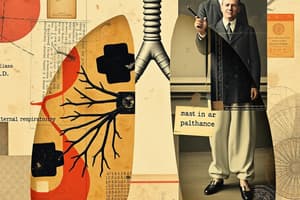Podcast
Questions and Answers
What is the calculated minute alveolar ventilation (VA) if tidal volume (TV) is 500 ml, breath rate is 20 breaths/min, and dead space volume (VD) is 150 ml?
What is the calculated minute alveolar ventilation (VA) if tidal volume (TV) is 500 ml, breath rate is 20 breaths/min, and dead space volume (VD) is 150 ml?
- 22000 ml
- 12000 ml (correct)
- 10000 ml
- 7000 ml
What is the primary mechanism for the transport of carbon dioxide through the membranes of alveoli and capillaries?
What is the primary mechanism for the transport of carbon dioxide through the membranes of alveoli and capillaries?
- Simple diffusion (correct)
- Active transport
- Convection
- Facilitated diffusion
What is the typical partial pressure of oxygen (pO2) in alveolar air?
What is the typical partial pressure of oxygen (pO2) in alveolar air?
- 60 - 70 mm Hg
- 155 - 159 mm Hg
- 105 - 110 mm Hg
- 95 - 110 mm Hg (correct)
What occurs when the partial pressure of a gas over a liquid exceeds its tension in the liquid?
What occurs when the partial pressure of a gas over a liquid exceeds its tension in the liquid?
Which of the following describes the value of anatomical dead space?
Which of the following describes the value of anatomical dead space?
What is the primary reason for the absorption of oxygen by an organism?
What is the primary reason for the absorption of oxygen by an organism?
Which organelle primarily consumes O2 in cells?
Which organelle primarily consumes O2 in cells?
What best describes the sequence of respiratory phases?
What best describes the sequence of respiratory phases?
What is the typical gas composition of inhaled air?
What is the typical gas composition of inhaled air?
Which zone of the lungs contains alveoli relevant for gas exchange?
Which zone of the lungs contains alveoli relevant for gas exchange?
What mainly contributes to the negative pressure in the pleural gap?
What mainly contributes to the negative pressure in the pleural gap?
During quiet breathing, the change in thoracic cavity volume is primarily due to the contraction of which muscle?
During quiet breathing, the change in thoracic cavity volume is primarily due to the contraction of which muscle?
What is the typical gas composition of alveolar air?
What is the typical gas composition of alveolar air?
What act of breathing involves external intercostal muscles?
What act of breathing involves external intercostal muscles?
What are respiratory muscles primarily classified as?
What are respiratory muscles primarily classified as?
During inspiration, the pressure in the lungs is:
During inspiration, the pressure in the lungs is:
What factors contribute to the expiration phase of breathing?
What factors contribute to the expiration phase of breathing?
If the transpulmonary pressure is equal to zero, what will happen to the lungs?
If the transpulmonary pressure is equal to zero, what will happen to the lungs?
The anatomical dead space in the respiratory system includes which of the following structures?
The anatomical dead space in the respiratory system includes which of the following structures?
What is the purpose of surfactant in the respiratory system?
What is the purpose of surfactant in the respiratory system?
How is functional residual capacity calculated?
How is functional residual capacity calculated?
The volume of air that a person can inhale and exhale comfortably while at rest is called:
The volume of air that a person can inhale and exhale comfortably while at rest is called:
What does minute ventilation (MV) refer to?
What does minute ventilation (MV) refer to?
The average value of tidal volume in healthy adults is approximately:
The average value of tidal volume in healthy adults is approximately:
What is the vital capacity defined as?
What is the vital capacity defined as?
Residual volume indicates which of the following?
Residual volume indicates which of the following?
Flashcards
Main purpose of O2 absorption
Main purpose of O2 absorption
To improve the efficiency of ATP resynthesis in cells.
Primary O2 consumers in cells
Primary O2 consumers in cells
Mitochondria are the main organelles that consume oxygen for cellular respiration.
ATP energy use
ATP energy use
ATP's energy is used for various cellular processes, including synthesis, active transport, and mechanical work.
Respiratory phases sequence
Respiratory phases sequence
Signup and view all the flashcards
Inhaled air O2/CO2
Inhaled air O2/CO2
Signup and view all the flashcards
Alveolar air O2/CO2
Alveolar air O2/CO2
Signup and view all the flashcards
Gas exchange location in lungs
Gas exchange location in lungs
Signup and view all the flashcards
Lung diffusion capacity
Lung diffusion capacity
Signup and view all the flashcards
Residual Volume (RV)
Residual Volume (RV)
Signup and view all the flashcards
Anatomic Dead Space
Anatomic Dead Space
Signup and view all the flashcards
Tidal Volume (TV)
Tidal Volume (TV)
Signup and view all the flashcards
Minute Alveolar Ventilation (VA)
Minute Alveolar Ventilation (VA)
Signup and view all the flashcards
How does CO2 move through membranes?
How does CO2 move through membranes?
Signup and view all the flashcards
External Intercostal Muscles
External Intercostal Muscles
Signup and view all the flashcards
Quiet Expiration
Quiet Expiration
Signup and view all the flashcards
Respiratory Muscles
Respiratory Muscles
Signup and view all the flashcards
Inspiration
Inspiration
Signup and view all the flashcards
Factors in Expiration
Factors in Expiration
Signup and view all the flashcards
Transpulmonary Pressure
Transpulmonary Pressure
Signup and view all the flashcards
Zero Transpulmonary Pressure
Zero Transpulmonary Pressure
Signup and view all the flashcards
Negative Pleural Pressure
Negative Pleural Pressure
Signup and view all the flashcards
Airway Functions
Airway Functions
Signup and view all the flashcards
Surfactant Function
Surfactant Function
Signup and view all the flashcards
Alveolar Air Renewal
Alveolar Air Renewal
Signup and view all the flashcards
Gas Exchange in Alveoli
Gas Exchange in Alveoli
Signup and view all the flashcards
Effective Ventilation Measures
Effective Ventilation Measures
Signup and view all the flashcards
Study Notes
External Respiration: Gas Exchange in the Lungs
- Purpose of Oxygen Absorption: The primary function of acquiring oxygen is to improve the efficiency of ATP resynthesis, the process of creating energy for cellular functions.
- Cellular Oxygen Consumers: Mitochondria are the primary organelles in cells that consume oxygen.
- ATP Energy Use: The energy stored in ATP is pivotal for various cellular activities including complex substance synthesis, active transport, and mechanical work.
- Respiratory Phases: The correct sequence of respiratory processes is ventilation, gas exchange in lungs, gas transport by blood, biological oxidation, and gas exchange in tissues.
- Inhaled Air Composition: Normal inhaled air contains approximately 20.9% oxygen and 0.03% carbon dioxide.
- Alveolar Air Composition: Alveolar air contains roughly 16% oxygen and 4.5% carbon dioxide.
- Exhaled Air Composition: Exhaled air has approximately 16% oxygen and 4-5% carbon dioxide.
- Gas Exchange Area: The respiratory zone of the lungs, containing alveoli, is the site of gas exchange with the blood.
- Lung Diffusion Capacity: The rate of gas exchange depends on the permeability of the alveolar and capillary membranes.
- Lung Stretch: Lungs are maintained in a stretched state during inspiration and quiet breathing.
- Pleural Pressure: The negative pressure within the pleural cavity (space between the lung and chest wall) is essential for maintaining lung expansion. Elastic recoil force is a major contributor to this.
- Inspiration Mechanism: Inspiration is primarily achieved by diaphragm contraction. Other muscles like external intercostal muscles play a critical role in forced inspiration.
- Expiration Mechanism: Expiration is a combination of elastic recoil and, in forced expiration, the contraction of expiratory muscles.
- Intra-Pulmonary Pressure vs. Atmospheric Pressure: During inspiration, the intrapulmonary pressure is lower than atmospheric pressure. The reverse occurs during expiration.
- Transpulmonary Pressure: The difference between intrapulmonary and intrapleural pressure is called transpulmonary pressure. This pressure difference is critical for lung inflation.
- Zero Transpulmonary Pressure: If the transpulmonary pressure is zero, the lungs will deflate.
- Pleural Cavity Pressure: The reason for the negative intrapleural pressure is the elastic recoil of the lungs and the surface tension of the alveolar fluid.
- Anatomic Dead Space: The conducting zone of the respiratory system, including the trachea, bronchi, and bronchioles, forms the anatomical dead space, which doesn't participate in gas exchange.
- Airway Functions: Respiratory airways warm, humidify, and filter inhaled air, and act as conduits for airflow.
- Surfactant Function: Surfactant reduces surface tension in the alveoli, preventing alveolar collapse during exhalation and facilitating lung expansion.
- Alveolar Air Renewal: Approximately one-seventh of the alveolar air is exchanged with each breath during quiet breathing.
- Continuous Gas Exchange: Gas exchange between air and blood happens constantly during both inhalation and exhalation.
- Effective Ventilation: The most reliable measure of effective ventilation is the assessment of PaO2 and PaCO2, arterial oxygen and carbon dioxide partial pressures.
- Tidal Volume (TV): The volume of air inhaled and exhaled in a quiet breath.
- Minute Ventilation (MV): The total volume of air moved in and out of the lungs per minute (TV x breaths per minute).
- Alveolar Ventilation (VA): The volume of air that reaches the alveoli per minute ((TV - VD) * breaths/min).
- Gas Transport: Carbon dioxide is primarily transported through simple diffusion across alveolar and capillary membranes.
- Alveolar Gas Partial Pressures: The partial pressure of oxygen (PO2) in alveolar air is typically 105-110 mmHg, and the partial pressure of carbon dioxide (PCO2) is about 38-40 mmHg .
- Gas Dissolution: A higher partial pressure of a gas above a liquid than in the liquid will drive the gas into the liquid.
Studying That Suits You
Use AI to generate personalized quizzes and flashcards to suit your learning preferences.




